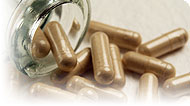health guides
Sulphur

How to Use It
No recommended intake levels have been established for sulphur. Since most Western diets are high in protein, the majority of diets probably supply enough sulphur.
Where to Find It
Most dietary sulphur is consumed as part of certain amino acids in protein-rich foods. Meat and poultry, organ meats, fish, eggs, beans, and dairy products are all good sources of sulphur-containing amino acids. Sulphur also occurs in garlic and onions and may be partially responsible for the health benefits associated with these items.1
Most of the body’s sulphur is found in the sulphur-containing amino acids methionine, cysteine, and cysteine. Vitamin B1, biotin, and pantothenic acid contain small amounts of sulphur.
Possible Deficiencies
Deficiencies of sulphur have not been documented, although a protein-deficient diet could theoretically lead to a deficiency of sulphur. Low levels of cystine, and therefore possibly sulphur, were reported many years ago in people with arthritis, but this association is far from proven.2
Copyright © 2024 TraceGains, Inc. All rights reserved.
Learn more about TraceGains, the company.
The information presented by TraceGains is for informational purposes only. It is based on scientific studies (human, animal, or in vitro), clinical experience, or traditional usage as cited in each article. The results reported may not necessarily occur in all individuals. Self-treatment is not recommended for life-threatening conditions that require medical treatment under a doctor's care. For many of the conditions discussed, treatment with prescription or over the counter medication is also available. Consult your doctor, practitioner, and/or pharmacist for any health problem and before using any supplements or before making any changes in prescribed medications. Information expires December 2024.


 We are proud to announce that
We are proud to announce that  As the market evolves, customers increasingly request a wider variety of omega-3 options for their lipid...
As the market evolves, customers increasingly request a wider variety of omega-3 options for their lipid...  Maintaining healthy glucose levels is crucial for preventing metabolic conditions like diabetes,...
Maintaining healthy glucose levels is crucial for preventing metabolic conditions like diabetes,...  Looking at formulating a new vitamin blend? Discover
Looking at formulating a new vitamin blend? Discover 







































